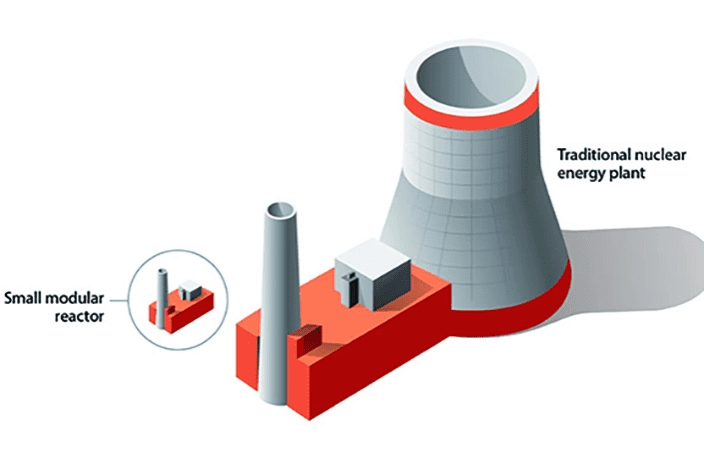On April 8th, 2024, a total solar eclipse will sweep across North America, from Mexico to the Maine-Canadian border. For those who experienced the spectacular solar eclipse of 2017, this one will be similar, crossing the United States from west to east and passing...

Hydrogen-powered cars are a promising technology. They are clean, could potentially be powered by renewable energy, and plus, they just sound like the future, right?
Hydrogen-powered cars, also known as fuel cell vehicles, are a type of electric vehicle: they use electricity to run a motor that turns the wheels. The car contains pressurized tanks of hydrogen and it passes the gas through a fuel cell to generate the electricity to run the motor. You can think of a fuel cell as a kind of electric generator, but instead of running on gasoline, it uses hydrogen as fuel.

Diagram of a fuel cell. Hydrogen comes in from the fuel tank and oxygen comes from the air. The flow of electricity (shown by arrows and -e, a symbol for electrons) powers the car’s motor. Finally, water goes out of the tailpipe.
The fuel cell is where a chemical reaction takes place to generate energy. In the fuel cell, hydrogen and oxygen come together to generate an electric current, water, and a bit of residual heat. In fact, water and heat are the only things that come out of the tailpipe! This means that fuel cell vehicles aren’t technically zero-emission vehicles, they are, at least, zero-pollution vehicles. Pollution from gasoline cars causes asthma, bronchitis, and an increased risk of cancer. A fleet of one hundred percent fuel cell vehicles would eliminate the health risk posed by dirty gasoline cars.
Beyond their lack of dirty exhaust, fuel cell cars are also quiet, especially when they’re driven slowly. They can also be fueled in under five minutes, unlike battery powered electric cars, which can take hours to charge. Finally, they also can drive around 200-300 miles on one tank of (hydrogen) gas.
Hydrogen-powered cars might sound like a technology of the future, but some people already own hydrogen fuel cell vehicles. Cars and SUVs powered by fuel cells are available in California, and with them has come a modest network of refueling stations. However, only 2,300 fuel cell cars sold in the US in 2018, are anemic pace compared to the millions of gasoline cars sold in the US each year.
With all their great qualities, why haven’t hydrogen-powered cars been widely adopted? It turns out there are some problems that are holding fuel cell cars back from widespread use.
The Three Main Problems Holding Back Hydrogen Fuel Cell Vehicles:
- Hydrogen generation
- Hydrogen distribution
- Vehicle cost
Hydrogen Generation

Photo by Oli Woodman on Unsplash
While hydrogen is an efficient fuel, generating hydrogen is not an efficient process. Currently, the primary method of making hydrogen in the US is from methane. To make hydrogen this way, engineers combine water and methane at high temperatures and to get hydrogen, carbon monoxide, and some carbon dioxide. Unfortunately, this process uses a fossil fuel and emits greenhouse gases. Hydrogen made in this way is mostly used by oil refineries. So while fuel cell vehicles only emits water, the process of making the hydrogen to power these vehicles causes pollution, so calling fuel cell vehicles zero-pollution is perhaps misleading.
For fuel cell cars to be sustainable, engineers have to adopt another method to generate hydrogen.
Right now, the main candidate is electrolysis. Electrolysis uses electricity to split water into hydrogen and oxygen. This process essentially works like a fuel cell in reverse: instead of using hydrogen and oxygen to generate electricity, it uses electricity to generate hydrogen and oxygen.
The problem with electrolysis is that, since the electricity used to create the hydrogen typically comes from the power grid, and about 60% of the electricity in the US power grid comes from fossil fuels. This means that, at least in the US, generating hydrogen in this way also emits greenhouse gases. In other words, like making hydrogen from methane, making hydrogen with electrolysis is not renewable or sustainable. When and if the power grid becomes fully renewable, though, cars fueled by hydrogen created through electrolysis will truly become zero-pollution.
Hydrogen Distribution
Engineers have constructed some infrastructure to distribute hydrogen across the US to fuel cars, but the network is not even close to big enough for a nationwide fleet of fuel cell cars. As of 2018, there were less than 50 hydrogen fueling stations in the US, nearly all of them in California (with one in Hawaii). Even in California, it takes careful planning to avoid getting stuck with an empty tank of hydrogen.
Besides getting your car to a hydrogen fueling station, it’s also hard to get the hydrogen there There are three major methods used for transporting hydrogen: through pipelines or on trains or trucks using either pressurized tanks or cryogenic liquid hydrogen containers.
Hydrogen pipelines are efficient, but they are rare and are mostly found near petroleum refineries in Illinois, California, and the Gulf coast. They exist here in these locations because petroleum comes from these areas, and hydrogen gas is used to refine petroleum. Building more hydrogen pipelines would be expensive, and it would be difficult to acquire the land rights to do so.

Photo by Patrick Hendry on Unsplash
Pressurized containers work well, but they’re expensive to produce, so they’re only used over shorter distances.
The third method, transporting hydrogen in cryogenic liquefied hydrogen tanks, is more cost-effective, but the liquid hydrogen tends to boil off, which can cause a dangerous situation. Liquid hydrogen is about -423 degrees Fahrenheit, so trying to keep the hydrogen contained is a like putting a pot of water on a hot stove and trying to keep the lid sealed: sooner or later the lid will pop off or the pot will explode.
The only way to prevent a tank of cryogenic liquid hydrogen from exploding is to gradually vent off the hydrogen to keep the pressure from raising too much. This means hydrogen can’t be left in liquid form for long: If you leave liquid hydrogen sitting around for too long, you will find you don’t have any hydrogen left at all!
What all this means is that, for hydrogen transported as a cryogenic liquid, the hydrogen can’t be left sitting around; it has to arrive just in time. This makes transporting it very difficult for all but planned uses of hydrogen, when it will be used as soon as it arrives.
An alternative solution is to generate hydrogen on the site of fueling stations using electrolysis and cut out the challenges with transporting it. However, the gain from eliminating distribution costs is diminished by the loss in cost savings from producing hydrogen at a mass scale that a centralized hydrogen generating source would enjoy.
High Cost
Perhaps the biggest barrier to adopting from hydrogen cars, from a consumer perspective, is the cost. Hydrogen fuel cell cars are significantly more expensive than their gasoline counterparts. For example, the Toyota Marai and the Hyundai Nexo, two hydrogen-powered cars on the market today, start around $60,000 each. These cars are partly so expensive because of the fuel cell, which requires the expensive metal platinum to catalyze the hydrogen reaction.
To make hydrogen-powered cars more affordable on a wide scale, scientists need to find less expensive catalysts.
Competition From Battery Powered Electric Cars
The biggest competitor to hydrogen-powered cars are cars powered by a different renewable energy source: electricity. Battery-powered electric cars, right now, are winning: Over 230,000 electric vehicles were purchased in 2018.
One major advantage for battery powered electric vehicles is that engineers have already solved the distribution problem: the infrastructure to deliver electricity is already in place and has been for some time. This helps make battery powered cars less expensive to power per mile than hydrogen fuel cell vehicles.
The Future of Hydrogen-Powered Cars
Fuel cell vehicles might sound exciting, but with all of these limitations, they are not yet a viable mainstream vehicle and they may not be for some time. I like fuel cell vehicles, so I wish I could be more optimistic. However, if electric cars charged with renewable energy become the standard, I will count our blessings and not mourn the loss of hydrogen cars.
For now, it’s an exciting technology and I can’t wait to see where it goes in the next ten, twenty, or thirty years.
Disclaimer: This article is not an endorsement of Toyota or Hyundai. Neither the author nor the Illinois Science Council has received any form of compensation from Toyota or Hyundai in relation to this article.





